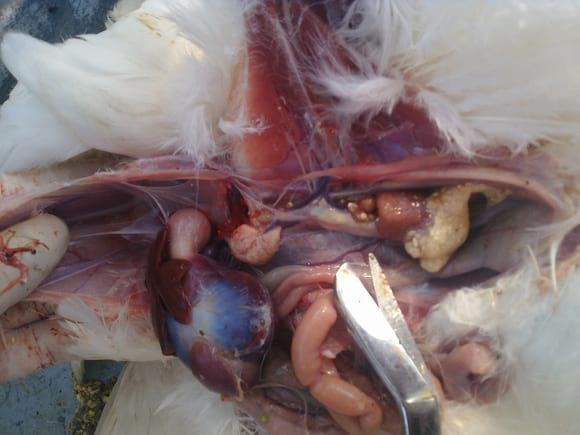Explore all the information on
Metabolic and nutritional diseases in poultry
Deficiencies or disturbances of nutrition cause a variety of diseases and can arise in different ways. The amount of a particular nutrient in the diet may be insufficient to meet the requirements, the diet may contain substances that inactivate the nutrient or inhibit its absorption/utilisation, or metabolism may be upset by the interaction of dietary and environmental factors. Peroxidation of lipids or oxygen free radical generation in general is a physiological process important for cell metabolism, division and differentiation and also for the biosynthesis of hormones and prostaglandins. Several common health conditions can affect poultry, including visceral gout, fatty liver syndrome, cloacal prolapse, osteomalacia, vitamin E deficiency, and ascites syndrome. Understanding these conditions and implementing appropriate management strategies can help prevent and treat them effectively.
Immunometabolism
The interface of the immune system and metabolism is an emerging field of study. Relatively recently, immunity and metabolism were treated as distinct processes carried out by an organism. Immunity was focused on the recognition and resistance to a pathogen and involved its own set of cells and tissue activities. Metabolism was solely the chemical...
Comments : 4
Recommendations: 14
Good litter management and proper ventilation are critical to preventing footpad dermatitis (FPD) and maintaining health in poultry flocks. Footpad dermatitis first became an issue for the poultry industry in the 1980s, but it surely existed long before that time. The condition is known by a variety of names, including pododermatitis and contact dermatitis. It is characterized by inflammation and ulcers on the footpad and toes. The sores can be shallow or deep....
Comments : 4
Recommendations: 1


Innovative Directions in Aflatoxin Testing Point to Measureable Gains in Quality Of Lab Data
Suggested link
INTRODUCTION Fumonisins are secondary metabolites of Fusarium verticilloides and were first isolated and chemically characterized in 1988 (Gelderblom et al. 1988). About 28 homologues have been discovered since then. However, from a toxicological standpoint, Fumonisin B 1 (FB) is the most common and studied homologue. Others, such as FB 2 , FB 3 , and FB 4 are less...
Comments : 0
Recommendations: 0
...
Comments : 2
Recommendations: 1
Cystic oviduct in broilers and layers is a common observation in many field cases with severe nephritis. Is it a pathognomonic lesion of any viral disease as IB kidny form or associated with nephritis? and what is the mechanism?...
Comments : 0
Recommendations: 0
Some Strategies to Alleviate the Incidence of Ascites in Broilers are 1. Higher level of Vitamin C, Vitamin E & Se 2. Addition of Sodium bicarbonate 1% 3. Addition of 0.2% Aspirin 4. Feed Restriction ...
Comments : 49
Recommendations: 0


Dirty egg problem solved by dietary tributyrin supplementation in layers
Suggested link
Introduction Footpad dermatitis (FPD) is a type of skin inflammation that causes necrotic lesions on the plantar surface of footpads in broilers and turkeys (Shepherd and Fairchild, 2010). Chicken feet or paws are considered a culinary delicacy in many cultures and have become the third most important economic part of the chicken (chicken breast and wings are the first and second,...
Comments : 0
Recommendations: 0
management for broiler farms and control medicines for crd,e-coli, mycoplasma...
Comments : 2
Recommendations: 0
Ascites, also known as"'water belly," is a disease in which fluid accumulates in a bird's abdominal cavity. The fluid may contain yellow protein clots, giving it a yellowish tinge.
Ascites arise mainly in broiler and layer chicks due to following reasons:
1. Poor Ventilation : In winter, farms has to be closed to prevent birds from cold air. Due to which huge amount of ammonia gets collected inside the farm which reduce oxygen inside the farm thus cause ascites.
2. High Protein Feed....
Comments : 0
Recommendations: 0
What can be the cause of chickens to brake the knee joint? I have 100 birds that have died... ...
Comments : 9
Recommendations: 0
INTRODUCTION Spiking mortality syndrome is a disease of uncertain etiology characterized by mortality (>0.5%) for approximately 3 consecutive days during the first 3 wk of life. Affected young broilers may experience tremors, blindness, ataxia, and coma; most are hypoglycemic (Davis et al., 1995). Because none of these clinical signs can be considered a specific identifying characteristic of the disease, spiking...
Comments : 0
Recommendations: 0
During the past cycle we experienced the following: mucoid enteritis; disfunctional ceacum; contents of ceacum is watery and filled with bubbles in the feed passage; undigested feed particles in the small intestine; wet droppings due to liquid ceacal content.There were no abnormal mortallitys.The growth performance were very poor and the feed conversion were also very poor. This scenario started at a age of 25 days till slaughter on 34 days. My personal feeling...
Comments : 0
Recommendations: 0
I am a broiler farmer in Kenya. I use brickets for heating in the houses. This invariably creates carbon dioxide, carbon monoxide . Ultimately, the birds suffer from ascites (waterbelly) . Any advice on how to cure this? Obviously at a reasonable prices and not a complicated system? Kind regards Musa. Ndeto ...
Comments : 0
Recommendations: 0
Nowadays, genetic improvements have provided chickens with faster growth in lower production periods. In this situation skeletal abnormalities and stress are the negative consequences of the chickens’ modifications (Robinson et al., 1992). On the other hand, feeding planners have to exert several feeding programs due to the alternating changes of birds’ requirements and also their welfare situation during the time (Shariatmadari,...
Comments : 0
Recommendations: 0
Postmortem findings : 1. Severe visceral gouts 2. Swollen kidney (with deposition of color urate crystal) 3. Proventicular ulceration 4. Normal liver 5. Notmal intestine Clinical findings : 1. Number of sick birds is 1-2% 2. Mortality 4-7% 3. Most of birds look normal History : 1. Different age group of birds (7 to 34 days)...
Comments : 0
Recommendations: 0
Leg problems can occur in fast-growing strains of broilers and turkeys. These disorders are not unique to small flocks; they also occur in commercial broiler and turkey flocks. Estimates of the incidence of leg and foot problems range from 0.5 to 4 percent of all broilers grown. What is a leg problem? Some birds may develop crooked legs, toes and feet; bowlegs; twisted joints; or swollen hock joints between the drumstick and the...
Comments : 9
Recommendations: 1
The ascites syndrome in broiler flocks has been increasing at an alarming rate, and this condition has become one of the leading causes of mortality and whole carcass condemnations throughout the world. Ascites represents a spectrum of physiological and metabolic changes...
Comments : 22
Recommendations: 0


Innovative Directions in Aflatoxin Testing Point to Measureable Gains in Quality Of Lab Data
Suggested link
Rickets can occur in young birds due to insufficient Vitamin D 3 , calcium and/or phosphorus. Commercial feeds and supplements provide these nutrients, but if they are over-diluted, the birds will not get enough. Birds can synthesize their own Vitamin D, to a certain extent, with exposure to sunlight. A deficiency of any of these nutrients can also lead to problems with egg-laying birds. Egg production may be reduced...
Comments : 10
Recommendations: 1

















.jpg&w=3840&q=75)













